
Dr. Sharma (left) will use IVUS in addition to traditional angiography and CT to identify VP.
Just how many deaths each year can be directly attributed to vulnerable plaque (VP) is still being studied. But researchers and clinicians are not underestimating the danger that may be lurking inside an arterial wall.
For many patients the first symptom of a ruptured VP is sudden coronary death. Yet not all sudden deaths can be tied to VP, asserts Michael Poon, M.D., director of Cardiology at the Cabrini Medical Center in New York and an associate professor of Cardiology at the Mount Sinai School of Medicine. “If the plaque is in the main coronary vessel and it ruptures, your entire left heart is in jeopardy. If the plaque is in one of the small tributaries, you may suffer a heart attack.”
According to Dr. Poon, approximately 325,000 cases of sudden death are reported in the U.S. each year. And each year there are about 500,000 heart attacks, of which maybe 25 percent are caused by VP, he said.
While some estimates put it as high as two-thirds to three-quarters, the number of individuals at risk for developing VP is still close to 50 million, Dr. Poon says.
Not Your Typical Plaque
Vulnerable plaques are unique in that circulatory problems are not caused by the plaque’s occlusion of a vessel, but by the clot that is formed after the plaque ruptures.
In explaining the biological processes involved, Dr. Poon says the destructive action of cholesterol on a vessel’s protective lining triggers the normal retaliatory action of monocytes, which “eat up” the molecules of cholesterol. This, in turn, draws more monocytes to the same area and, over time, a plaque forms. But because this plaque has a lipid core that extends into the vessel wall and is covered only by a thin, fibrous cap, it can erupt like a mini-volcano. And that sends cytokines (immunoregulatory proteins) into the bloodstream that attract more blood cells to form a thrombus.
What actually causes these plaques to erupt or their fibrous caps to erode is still a mystery, although inflammation of the lesion is a prime suspect. Likewise, how “vulnerable” these plaques are to rupturing keeps cardiologists guessing. “I can’t look at a plaque and tell you that there’s X-amount of chance that it’s going to rupture,” said Edward Shapiro, M.D., a professor of Medicine and director of Noninvasive Imaging at Johns Hopkins Bayview Medical Center.
Until recently, VPs have mostly been discovered during postmortem examinations. But new advances in imaging technologies are making it easier to discover them in living patients. And studies are now under way to identify those individuals who are at greatest risk.
Tracking Trends
The first-ever study to focus on the progression of plaque in patients suffering from acute coronary syndrome is now in the follow-up period, says Gregg Stone, M.D., a professor of Medicine at Columbia University Medical Center and chairman of the Cardiovascular Research Foundation.
As principal investigator of the PROSPECT (Providing Regional Observations to Study Predictors of Events in the Coronary Tree) study, Dr. Stone said this follow-up period will last from two to five years and will follow patients through normal treatment cycles. But he stresses that since the purpose of this study is to observe and collect data, researchers are not intervening at any level of treatment. “PROSPECT is the first study that is trying to identify vulnerable plaque,” he said. “Until now, it’s been impossible to distinguish between soft, pliable plaques filled with lipids and hard, stable plaques.”
But this study goes beyond just identifying VP, he said. “Hopefully we can predict which plaques and which patients are going to be in trouble.”
As a result, researchers are looking at patient histories, risk factors and systemic biomarkers for inflammation, and are carefully tracking the progression of lesions to see whether they turn into VPs or disappear, he said.
Sponsored by CA-based Abbott Vascular (formerly the vascular division of Guidant Corp.) and Rancho Cordova, CA-based Volcano Corp., this multicenter study began enrolling patients three years ago. A total of 700 patients in both the U.S. and Europe are being studied.
To better visualize plaque, researchers are using Volcano’s Virtual Histology Intravascular Ultrasound (VH IVUS) technology which gives a clearer picture of a plaque’s morphology and can even detect lipid in a plaque. “We knew that angiography only shows the inner walls of an artery but doesn’t have the power to tell us what’s going on inside the wall,” Dr. Stone said.
Volcano’s VH IVUS uses advanced spectral analysis techniques and classifies atherosclerotic plaque color images into four component types: fibrous, fibro-fatty, dense calcium and necrotic core. It then uses a predetermined color key to display plaque compositions.
Using this powerful imaging tool appears to have made a difference in the PROSPECT study. Interim data on 250 of the 700 patients showed that lesions with presumed characteristics of VP were found in 35 percent of patients.
Searching For Better Images
The need to visualize every aspect of a plaque as well as the arterial wall has led to advances in conventional imaging technologies. While some of the more conventional modalities like MRI and CT still have limitations, researchers have been successful in expanding their capabilities.
Zahi Fayad, Ph.D., FAHA, FACC, professor of Radiology and Medicine (Cardiology) at the Mount Sinai School of Medicine and director of the Translational and Molecular Imaging Institute, is leading the effort to expand the role of MRI and CT in identifying VPs.
As early as 2001, Dr. Fayad concluded that depending on where the plaque was located, high-resolution magnetic resonance (HRMR) had the potential for identifying VPs. “Carotid lesions are different from coronary lesions,” he said. “While they share 90 percent of features, carotid lesions may be a little more stenotic and lipid-rich.”
In January 2007, Dr. Fayad published the results of a study in which mice were injected with a synthetic material, gadolium, which tracks down and attaches itself to macrophages embedded in the arterial wall.
Twenty-four hours after the injection, MRI tests showed that measuring and assessing macrophages in the arterial walls yielded a 79 percent increase in detection compared with the initial baseline images taken the day before.
Another preclinical study, published in April, used 64-slice CT imaging technology and an iodinated nanoparticulate contrast agent called N1177 developed by NanoScan Imaging.
Rabbits that were fed a high-fat diet were injected with this contrast agent. When compared to images using a conventional CT contrast agent, scans taken after using N1177 clearly showed the macrophages within the arterial walls. “We were amazed at these results,” Dr. Fayad said at the time the results were published. “The introduction of N1177 allows us to look directly inside the walls of the coronary arteries and to pinpoint these dangerous, heart attack causing plaques.”
But as to which noninvasive technology is best, Dr. Fayad says it depends on where you’re looking for the plaque. “MR is very good at looking at almost all structures except the coronary artery because the heart is beating. CT imaging of the coronary artery is routine.”
As to which method under investigation may be the first to enter human clinical trials, Dr. Fayad said, “We are on a faster track with CT than with MRI.”
The value of MRI and CT scans in identifying VP also is supported by Drs. Poon and Shapiro.
While Dr. Poon acknowledges the advancements made in MR technologies, he said, “It doesn’t have the speed. You can’t get the resolution you need.” Yet he admitted, “MR is better at detecting a lesion. You can tell fatty tissue from fibroblasts.”
However, CT imaging gives far more depth, he said.
For the past seven years Dr. Poon has been using the AQPlaque suite of vascular analysis tools from TeraRecon with a CT scanner. The addition of this plaque analysis software has allowed Dr. Poon and his colleagues to “delineate the various components of plaque,” he said.
Designed for use with the Aquarius workstation, this software allows clinicians to evaluate a wide range of parameters related to plaque constitution and morphology, including the overall extent of wall remodeling, luminal encroachment and the density distribution of CT values within the plaque. The tools also provide for the reporting of luminal area and vessel cross-sectional dimensions for comparisons with data gathered through angiography and IVUS imaging.
For Dr. Shapiro, the latest imaging technology includes a new visualizing software tool called SUREPlaque.
Developed by Vital Images Inc., SUREPlaque is a separate module in the company’s ViTALCardia suite of tools that focuses on coronary plaque characteristics.
According to Dr. Shapiro, Vital Images has been working with Toshiba America Medical Systems to create a common software solution so that images generated by a Toshiba CT scanner can be analyzed on a Vital Images workstation. “In most medical centers, the images are evaluated using the Vital Images console,” he said. “This tool allows for the measurement of total amounts of plaque, the extent of remodeling, the density of plaque and spotty calcification in a semi-automatic way.”
“We’re using it in patients who have already had a CT angiogram,” he continued. “When we find plaque that has several characteristics, we are more concerned.”
These characteristics include: plaques that demonstrate significant remodeling, meaning that they have grown outward from the vessel wall; regions of low density within the plaque, which may indicate a higher lipid content; and spotty calcification with measurements of less than 3 mm.
By analyzing these characteristics, Dr. Shapiro says it’s easier to determine if these plaques are VP and whether they are at risk of rupturing. “These three features have been shown to be more common in vulnerable plaques,” he stated.
While great strides are being made in noninvasive imaging, the general consensus is that the most detailed imaging still comes from IVUS.
Barry Rutherford, M.D., professor of Medicine and director of Interventional Research at the Mid America Heart Institute of St. Luke’s Hospital in Kansas City, MO, says he has been tracking 41 patients as part of the PROSPECT study. For over three years he and his staff have been using Volcano’s VH IVUS to identify VP. “If you look at a plaque with a greater than 10 percent necrotic core that is close to the lumen of the artery, it’s most likely a VP,” he said.
But visualizing such characteristics as fibrous tissue and a lipid-rich core requires a high-resolution image, he says. “The VH IVUS can identify these elements with a specificity of 94 to 95 percent.”
And the VH IVUS is much more refined than conventional IVUS, he notes. “Most grayscale IVUS can show the amount of blockage, but not the kind of plaque.”
Not surprising, the reliance on IVUS for distinguishing between plaque types is growing.
Samin Sharma, M.D., director of the Interventional Cardiology and Cardiac Catheterization Laboratory at Mount Sinai Heart, which is part of New York’s Mount Sinai Medical Center, says he is in the process of installing the latest IVUS equipment from Boston Scientific called “iLab.”
One mobile and two mounted iLab systems will be used in conjunction with other imaging systems, he said. “We’re not doing IVUS in place of CT. We’re using it for additional identification.”
Dr. Sharma said CT works well if there is no calcification. If there is, the reading can be wrong 30 to 40 percent of the time. As a result, patients will continue to undergo angiography, but to determine the composition of plaque and its chances of being vulnerable plaque, additional imaging will be done using IVUS.
Treatment Options
Most cardiologists begin treatment by putting patients on a low-cholesterol diet to see if they can reverse the process. After that, medication is the order of the day.
There is, however, another treatment option — the use of stents to treat VP — that is causing some controversy among interventional cardiologists.
Dr. Poon said stents are sometimes used to stabilize the plaque by pushing it deeper into the wall. But he admitted, “You basically are sweeping it under the rug.”
“I think it’s a misuse of stenting because we are not good enough yet in picking out plaques that are at high risk of rupturing,” Dr. Shapiro said. “Even if it’s a drug-eluting stent, the patient is at risk of developing a thrombus. And that’s too big a jump. There needs to be more data before that step is taken.”
Dr. Sharma says a stent can lower the risk of a VP rupturing. Yet he added, “You really cannot treat VP using a stent. You need aggressive medical treatment.”
Dr. Rutherford weighs in by saying that the major concern about using a stent is that you can accidentally rupture the plaque — thus creating the problem you wanted to avoid. But he also holds out hope for the future. “Already in development is a completely absorbable stent that would be gone in a year,” he said.
Looking even farther into the future, Dr. Stone envisions a time when highly-selective nanoparticles will be used to target macrophages in patients diagnosed with VP. “This truly is the age of personalized medicine,” he said.





 August 27, 2024
August 27, 2024 








